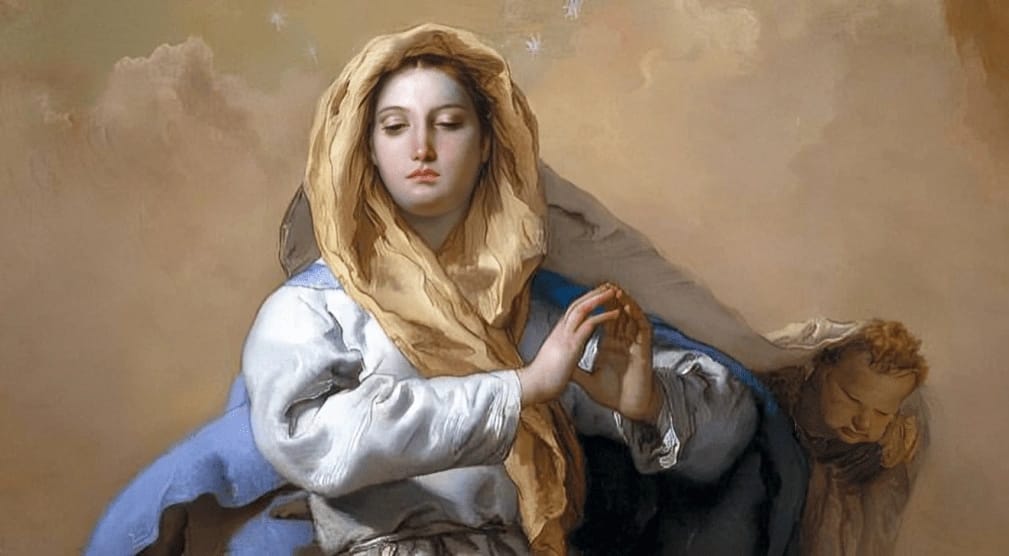The Immaculate Conception is one of the most significant doctrines of the Catholic Church, central to the understanding of Mary’s purity and her role in salvation history. Declared as an official dogma of the Church by Pope Pius IX in 1854, this teaching asserts that Mary, the mother of Jesus, was conceived without original sin, making her uniquely qualified to bear the Son of God. The phrase “Mary conceived without sin” points to this divine protection, which allows her to be a fitting vessel for the incarnation of Christ.
But why is this doctrine so important? How does it guide us in our spiritual journeys? This exploration delves into the significance of the Immaculate Conception, its biblical and theological foundations, and the profound spiritual lessons it offers to the faithful.
Understanding the Immaculate Conception: The Dogma Defined
The Immaculate Conception refers specifically to Mary’s conception in the womb of her mother, Saint Anne, without the stain of original sin. It is important to note that this doctrine does not concern the virgin birth of Jesus, but rather Mary’s own conception—her sinlessness from the moment of her conception in her mother’s womb.
According to Catholic teaching, all human beings inherit original sin from Adam and Eve. This original sin is washed away through Baptism, but in the case of Mary, God chose to preserve her from this stain from the very beginning of her life. This unique grace was given to her in anticipation of the role she would play as the Mother of the Savior.
The dogma was officially proclaimed in the papal bull Ineffabilis Deus on December 8, 1854, by Pope Pius IX, who wrote:
“The most Blessed Virgin Mary was, from the first moment of her conception, by the singular grace and privilege of Almighty God, and in view of the merits of Jesus Christ, Savior of the human race, preserved immune from all stain of original sin.”
This declaration set the Immaculate Conception apart from other Marian teachings, making it clear that Mary was wholly pure in a way that no other human being had been. She was the one person exempted from original sin so that she could be the worthy vessel for the incarnate Word of God.
Biblical and Theological Foundations of the Immaculate Conception
While the phrase “Immaculate Conception” is not explicitly mentioned in the Bible, Catholics see biblical roots in this dogma, drawn from both Old Testament types and New Testament revelations about Mary.
1. The Protoevangelium (Genesis 3:15)
The first indication of the Immaculate Conception can be traced to the Book of Genesis, specifically Genesis 3:15, which is often referred to as the Protoevangelium—the first announcement of the Gospel. In this passage, God speaks to the serpent, Satan, after the fall of Adam and Eve:
“I will put enmity between you and the woman, and between your offspring and hers; he will strike at your head, while you strike at his heel.”
In Catholic interpretation, the “woman” mentioned here is a prophetic reference to Mary, and her offspring is Jesus Christ. The enmity between the serpent and the woman symbolizes the victory of Mary and her Son over sin and Satan. The Church interprets this as an indication that Mary was preserved from sin to be the one who would bring forth the Savior who would ultimately crush the head of the serpent (Satan).
2. The Annunciation (Luke 1:28)
In the Annunciation (Luke 1:28), the Angel Gabriel greets Mary with the words: “Hail, full of grace, the Lord is with you.” The phrase “full of grace” (Greek: kecharitomene) is understood to mean that Mary is perfectly graced by God. Catholic theologians argue that this expression indicates Mary’s sinlessness, as she is described as entirely graced—a grace that preserved her from sin. This angelic greeting is seen as a sign of her purity, and it aligns with the belief that she was uniquely prepared to bear the Christ child.
3. The Role of Mary in Salvation History
The Church teaches that Jesus, the New Adam, came to redeem humanity from sin. If Jesus, as the Savior, was completely pure and sinless, it follows that His Mother, the one who would carry Him, should be equally pure and preserved from sin. As the Church teaches in the Second Vatican Council’s document Lumen Gentium (1964):
“In the most Holy Virgin, the Church has been endowed with the model of all virtues, and especially of the perfect realization of love and holiness.”
Mary’s Immaculate Conception is understood as God’s way of ensuring that she was spiritually fit to be the Mother of God—a woman of complete grace, free from sin and the effects of original sin.
The Spiritual Meaning of the Immaculate Conception
The dogma of the Immaculate Conception offers profound spiritual insights for the Catholic faithful. This doctrine is not simply a theological assertion but a spiritual guide for Christians today.
1. God’s Grace and Human Freedom
The Immaculate Conception emphasizes the importance of God’s grace in the process of salvation. While all humans are born with original sin, the Church teaches that Mary was preserved from it through God’s gracious intervention. Her conception is an example of how grace can transform a person’s nature.
Mary’s freedom from sin did not come from any intrinsic worth of her own but from God’s grace. This reinforces the Catholic teaching that no one can save themselves; salvation is a gift from God. Mary’s role as the “new Eve” reflects this fundamental truth: just as Eve played a role in bringing sin into the world, Mary, through her obedience and purity, plays a key role in bringing Christ into the world for our redemption.
2. A Call to Purity and Holiness
Mary’s sinlessness serves as a model of purity and holiness for all Christians. The doctrine invites us to reflect on our own spiritual lives and how we respond to God’s call to live in holiness. Mary’s example shows that grace does not negate human freedom; rather, it empowers us to make free choices that align with God’s will. In a world often filled with temptation and sin, the Church calls the faithful to strive for holiness, to resist sin, and to cultivate virtues such as humility, purity, and charity.
3. Our Own Journey of Redemption
The Immaculate Conception also points to the possibility of redemption for all people. If God could preserve Mary from sin, then He can also help us on our own journey toward holiness. As the Mother of all Christians, Mary is a guide who leads us closer to her Son, Jesus Christ. Catholics often turn to her in prayer, seeking her intercession and guidance as they strive to overcome sin in their own lives.
By invoking Mary, particularly through prayers like the Rosary, the faithful are reminded of her perfect submission to God’s will and her complete reliance on divine grace.
The Immaculate Conception and the Church Year
The Feast of the Immaculate Conception is celebrated annually on December 8th. This feast is not only a celebration of Mary’s sinless conception but also a reminder of the hope and redemption that God offers to all of humanity. The feast is an opportunity to reflect on God’s grace, purity, and holiness and to renew our commitment to live out these virtues in our daily lives.
In some cultures, this feast is a time for devotions, processions, and acts of charity, as believers reflect on Mary’s unique role in salvation and seek to emulate her virtues.
Conclusion: The Immaculate Conception Guides Us Home
The dogma of the Immaculate Conception reminds Catholics of God’s incredible love and the grace available to all humanity. Mary’s sinlessness allows her to be a guiding light to all Christians, showing that God’s grace can lead us home to Him, despite the challenges and temptations of life. By reflecting on Mary’s life, purity, and obedience, the faithful are invited to seek holiness, rely on God’s grace, and walk confidently toward eternal life in Christ.
In the end, the Immaculate Conception is not just a historical dogma, but a living spiritual truth that calls all of us to a deeper relationship with God and a life of grace and holiness. Mary’s example provides a hopeful guide that, with God’s help, we too can overcome sin and be made pure in His sight.





